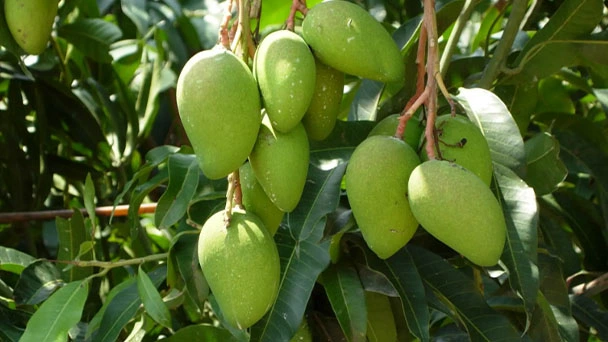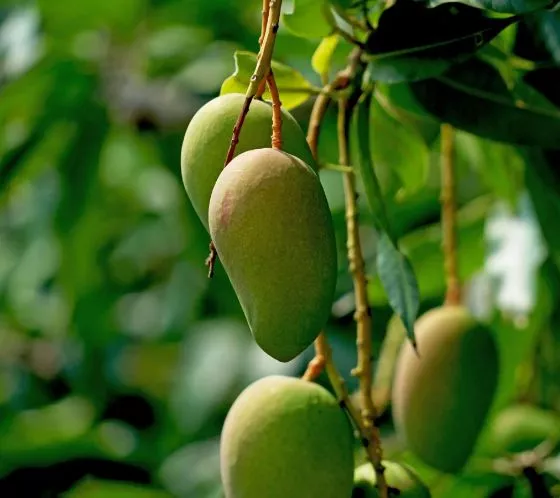How to Grow & Care for Dwarf Mango Tree
Written by Ivy
Dec 13 2022

In order to keep mango trees compact and small, I'll demonstrate how to choose, prune, and take care of Dwarf Mango Trees in this article.
Although some varieties of mango trees can also be grown in temperate climates as long as there is no risk of frost, warm tropical and subtropical regions are the best places to grow mango trees.
Mango trees can reach a height of 33 feet (10 meters), but you can keep them at a manageable, smaller size by routinely pruning them.
How to Grow Dwarf Mango Tree
Soil
The ideal soil is the first requirement for any dwarf mango tree. You want soil that has adequate organic matter, light, and good drainage. Between 5.5 and 7.5, or neutral to slightly acidic, is the desired pH range. Instead of using common garden soil, you might want to look for a good potting mix. Additionally, add some aged manure or compost to the mixture when you first plant it.
Positioning
Mangos thrive in warm, humid climates, so even a dwarf mango tree in a pot will need a lot of heat and sunlight to grow. In order for the plant to be productive and grow properly, the ideal conditions for this plant call for at least 8 hours of full sun exposure. Given this, if you have a garden, place the mango so that it faces either the West or the South.
Watering
Mango trees are known to grow without receiving excessive amounts of water, if you've asked around about them. That is only accurate, though, when referring to plants that are grown underground. During the first two years of their life cycle, dwarf mango plants grown in containers will require routine watering. You should only lightly water the tree during the pre-flower period once the tree begins to bear fruit.
Fertilizer
You ought to give the tree a balanced fertilizer while it is still actively growing. As soon as the blooming season begins, you should reduce the nitrogen levels and feed the tree fertilizer that is rich in phosphorus and potassium.
Pests
Keeping in mind its typical pests is necessary if you want your tree to flourish. And these are the Hoppers, Mealybugs, Scale, and Spider Mites. A mango tree that has been attacked by these will produce fewer fruits as a result of the vigor loss. Early on in the lifecycle of the tree, you should use organic pesticides to control such pests.
Benefits of Keeping Mango Trees Small
Increased sunlight and air circulation are made possible by an open canopy with lots of space between the branches, which lowers the risk of fungi diseases.
Larger, higher-quality fruit can be produced by smaller mango trees because they can devote more energy to this task.
Compared to large, unpruned trees, small trees yield more and remain productive for a longer period of time.
Smaller trees allow you to fit more in your backyard and are much simpler to harvest fruit from.
How to Make Dwarf Mango Tree Smaller
Choosing a Small Mango Tree
Choosing the appropriate variety of mango tree for your garden is the first step in maintaining small mango trees.
The compact nature of dwarf mango trees means that they will only grow to a height of 10 to 13 feet (3 to 4 meters), making them perfect for small backyard gardens.
Their diminutive size also makes it simple to cover them in netting to keep birds away or to grow them in a greenhouse in colder climates.
Sensation, Palmer, and Irwin are a few varieties of common dwarf mango.
Planting Mango Trees in Containers
Mango trees in pots don't require much space, making them ideal for balconies, courtyards, and decks.
To prevent the soil from becoming waterlogged, choose a sizable container with drainage holes in the bottom and a high-quality potting mix that drains well.
Put the container in a location that gets at least six hours of direct sunlight every day.
During the spring and summer when they are actively growing and producing fruit, mango trees require a lot of water.
During prolonged dry spells, give them a thorough watering, and during the spring and summer, fertilize them with a liquid fertilizer every two to three weeks.
You can stop fertilizing and cut back on watering once the weather begins to cool in the fall.
Pruning Mango Trees
Mango trees grow quickly, so pruning is required on a regular basis to keep them compact and small.
Mango trees should be pruned after the fruit has been picked, but diseased branches can be cut off at any time of the year to keep the trees healthy.
To train trees into the desired shape, begin pruning them when they are still young.
By pruning the tree's top, you can reduce its height and encourage the growth of new branches on its sides, which will give the tree a fuller appearance.
Thin out the central branches and cut back any branches that are growing inward.
To make the most of the available space, mango trees can also be espaliered on a wall or fence so that they grow flush with the surface.
Mango trees in pots grow more slowly than those in the garden, but they will also gain from a yearly pruning to keep them small.

How to Grow Dwarf Mango Tree
in a PotThe first thing to do when growing a dwarf mango tree in a pot is to choose a dwarf mango variety. It couldn't grow if it didn't.
The dwarf mango tree will bear fruit in a short time, even in a pot. Therefore, firstly, choose a dwarf variety. We must make sure to get quality dwarf mango tree seeds.
An appropriate size for a pot is a dwarf mango tree, which can reach heights of 7–13 feet (2-4 meters).
Types of dwarf mango trees. Mangoes of many varieties, including the Irwin and Nam, stand out among those that can be grown in a pot. The Glenn, Carrie, King of Thailand, Palmer, and Cogshall varieties are a few more.
How to Grow Dwarf Mango Tree – Step by Step
Let's start step by step by explaining in detail How to Grow Dwarf Mango Tree in a Pot.
To start the process of growing dwarf mango, we will start by planting the dwarf mango tree seeds in a pot of the right size for the plant, later we must update the pot periodically as the plant gets bigger.
Use a dark-colored pot if you live in a cold climate area because mangoes prefer heat and the black color can absorb it in a certain way. This is good advice on how to grow dwarf mangoes.
Also make sure the pot has good drainage holes, as this plant does not like wet soil. Moving the pot from the tree to the interior during the winter is necessary. Make sure you can move the container easily if you live in a region where the cold is a constant.
The best time to start the process of growing mangoes is in the spring, however, this depends on the variety.
Care for a Dwarf Mango Tree in a Pot
Dwarf mango tree care in a pot. It should be fertilized with a balanced fertilizer when it is fully grown. At the beginning of the flowering, the amount of nitrogen should be decreased and its feeding should be increased with high amounts of fertilizers with potassium and phosphorus.
Its growth can be stimulated by ongoing pruning. The mango tree does not require continuous pruning, however, it is necessary to prune dead and diseased branches, as well as control their shape. Remember that too much pruning can reduce fruit production the following year.
How to Growing in Colder Climates
As previously mentioned, you might also try growing a dwarf mango tree in a colder region. However, in that situation, you must take all reasonable steps to ensure that the tree receives as much heat as possible. Put it in a pot or container that is a darker shade of color, for instance; black and other dark hues tend to absorb and retain more heat. Make sure the pot has enough bottom drainage openings as well.
Also, once the temperatures begin to fall, you should cover the pot with bubble wrap. If possible, place the pot in a greenhouse or indoors during the winter. All that is required for it to grow is a completely frost-free environment.
Final Words
After flowering, the ripening of the mango fruits occurs in the next 2-4 months, this depends a lot on the climate and the variety you have planted.
Pick the fruits when they are fragrant, according to the experts. The fruits, which are frequently used to make sorbets, pickles, and hot sauces, can also be harvested before they are fully ripe.
Latest Updated
- Benefits of Bugleweed - 7 Science-backed Health Benefits
- Bugleweed Dangers & Side Effects - Is It Poisonous?
- How to Plant Evergreen Trees - What You Should Know
- When to Plant Evergreens - Grow Guide for Evergreen Trees
- 12 Wonderful Evergreen Shrubs for Your Garden
- 12 Popular Evergreen Plants with Pictures for Beginners
- When And How To Prune A Lilac Bush Like a Pro
- How to Grow & Care for Lilac Vine (Hardenbergia Violacea)
- Japanese Lilac Tree (Syringa Reticulata) Care & Propagation Guide
- Shumard Oak Pros and Cons - What to Know
Popular Articles
- Winter maintenance of Antirrhinum Majus
- How to Grow Terminalia Mantaly Tree
- How to Grow and Care for Crossostephium Chinense
- How to grow Antirrhinum Majus in spring
- Peristeria Elata (Dove Orchid) Profile: Info & Care Guide
- Underwatered Snake Plant (Sansevieria Trifasciata) - Signs And How To Fix
- How to Care for Brazilian Jasmine Plant (Mandevilla Sanderi)
- How to Grow & Care for Graptopetalum Purple Delight in Summer
- Rosa Chinensis (China Rose): Plant Growing & Care Tips
- How to Care for Baby Sun Rose (Aptenia Cordifolia)